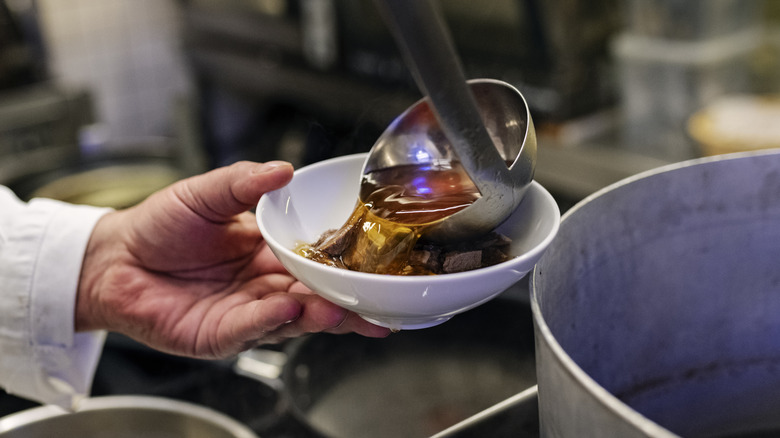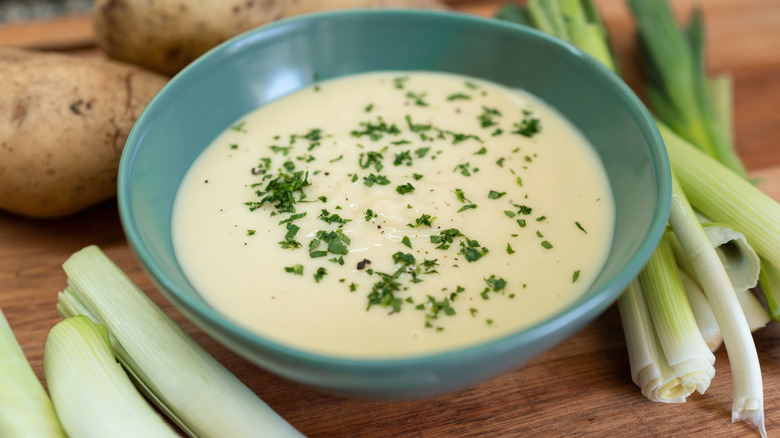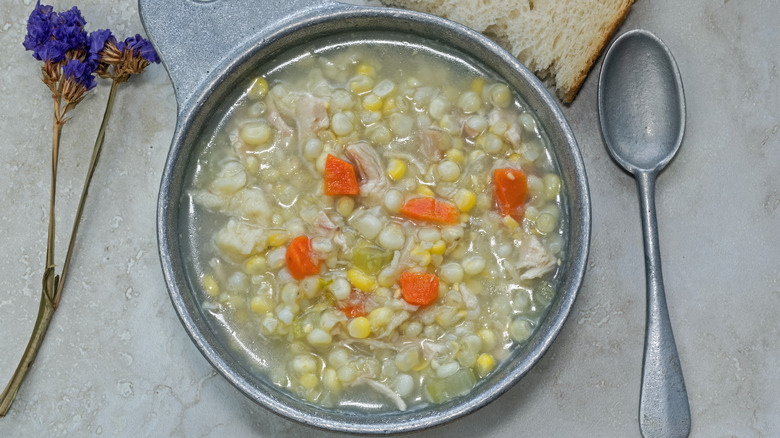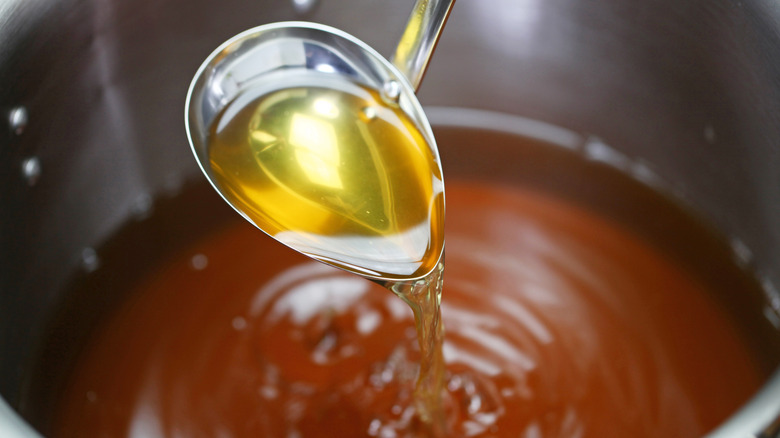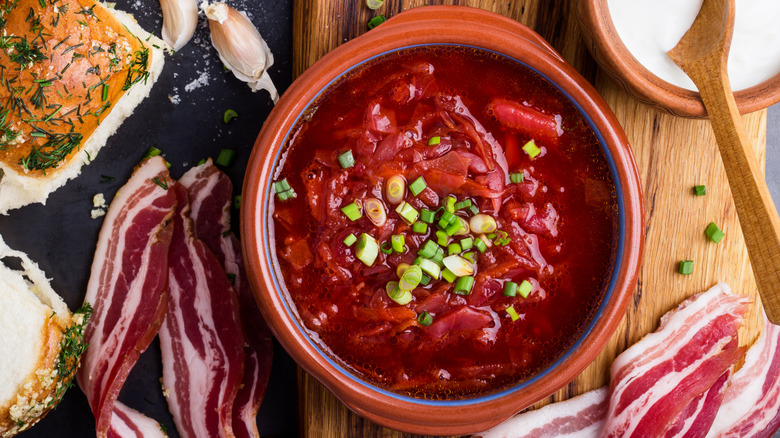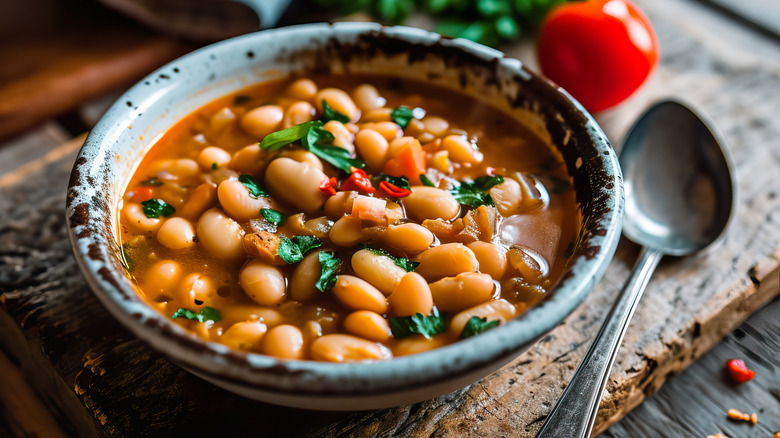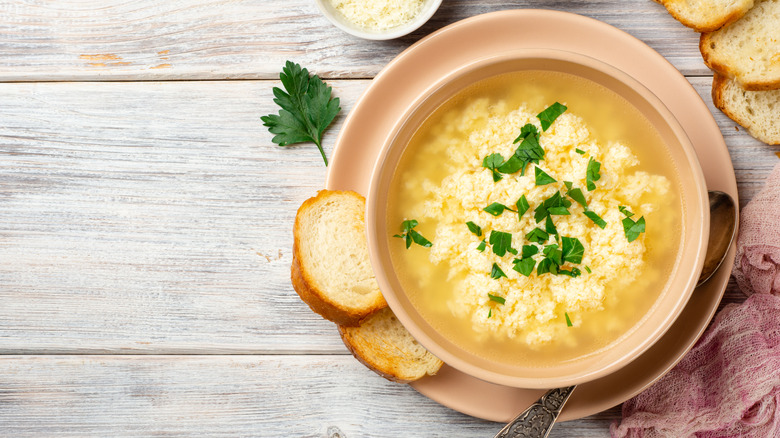Vintage Soups That Restaurants Rarely Make Anymore
Food trends come and go so quickly, and no dish is immune to the changing tastes of time. This also applies to soups, whether they're made with fresh or canned ingredients, with seafood, veggies, or meat, or served hot or cold. Some vintage soups on this list are made with traditional ingredients and have been passed down through the generations, while others were fads created to reflect popular foods at the time. Not only are several of these old-fashioned soups not really made in many home kitchens anymore, they're also rarely served in restaurants. Some of this is due to changing palates, or the availability and cost of specific ingredients.
While some of these soups may be dated, many are still delicious, and can even be updated to accommodate dietary restrictions and personal preferences. Whether it's a full-flavored beef consommé, a hearty bean soup with an interesting political past, or a rich and creamy seafood stew made with fresh ingredients, you'll find ample inspiration from restaurant menus from the past. Even if they aren't popular with diners anymore, many old-fashioned soups are still comforting and satisfying, serving up nostalgia one spoonful at a time.
Turtle soup
Turtle soup may not sound very appetizing, but it was once considered a delicacy in the United States. The concoction of broth, turtle meat, and veggies dates back to the 18th century, when the animals were hunted and turned into a feast soon afterward. The soup first showed up on restaurant menus in the mid-1800s, and was typically made with green sea turtles, or diamondback terrapins.
Over the next few decades and into the early 20th century, turtle soup or stew was found on many upscale eatery menus, until the reptiles were nearly hunted to extinction. Overfishing, as well as changing palates, resulted in many restaurants removing the soup from their bills of fare. Today, a few eateries such as Commander's Palace in New Orleans may still offer it on their traditional menus, but generally Americans have stopped eating turtle.
If you happen to have some turtle meat, you can recreate this classic soup by bringing it to a boil in a heavy saucepan, and then adding chopped onion, bay leaves, and spices such as cayenne pepper. Cover the pan and allow the meat to simmer for approximately two hours, or until tender. Add some chopped hard boiled eggs, citrus juice, and fresh parsley before serving, plus a little sherry at the table. Alternatively, try mock turtle soup, traditionally made with veal or gelatinous calf's head — or simply ground beef for a more modern version – and also finished with a dash of sherry.
Vichyssoise
Smooth and velvety vichyssoise is a French-style cream of potato and leek soup with a history as rich as its texture. According to many food historians, vichyssoise was created in the early 1900s by Louis Diat, a chef at the Ritz-Carlton in New York, although some believe it dates back earlier.
Even though thick and creamy vichyssoise is filled with substantial ingredients such as leeks, potatoes, heavy cream, butter, and chicken stock, it makes a refreshing lunch or dinner during the hot summer months since it's chilled in the refrigerator before serving. Although once a staple item on upscale restaurant menus, it's rarely seen these days.
Next time you're craving a satisfying bowl of soup but don't want something hot, consider making your own. Although whipping up a batch of vichyssoise, the classiest cold potato soup, is labor-intensive, you can enjoy it for a few days as it tends to get even more flavorful as it sits. Start by sauteing leeks in a heavy saucepan, and adding potatoes and chicken stock — bring the mixture to a boil and simmer until the veggies are soft. Blitz the soup in small batches with a blender, then whisk in heavy cream. Season with salt, pepper, and nutmeg, bring the soup to room temperature, then chill before serving.
Gazpacho
Cool and creamy gazpacho joins the ranks of other refreshingly chilled soups that are ideal for enjoying during the summer. This traditional Spanish soup has a history dating back centuries, and is a delightful combination of pureed boiled and crushed bread, fresh tomatoes, peppers, olive oil, and garlic, all chilled to perfection. The cold soup is sometimes served with tomatoes, cucumbers, bread, and hard-boiled eggs.
Although it has a tangy tomato base, don't call Andalusia's signature gazpacho "cold tomato soup," because it has so many other layers of fresh flavor. While it may not be as popular in restaurants as it was between the 1960s and 1990s in the U.S., the richly flavored cold soup is ideal for enjoying al fresco on your patio on a sweltering day or evening, and it's easy enough to make.
Start by soaking white bread in water and then mashing it with peppers, ripe tomatoes, and garlic cloves. Add in olive oil, sherry vinegar, water, and salt and pepper to taste, and then mix everything in a blender until it has a smooth, velvety texture. Chill in your refrigerator before serving, and add toppings to taste.
Avgolemono soup
Rich and silky with a bright, citrussy flavor, avgolemono is a classic and comforting Greek chicken soup. Some food historians claim that avgolemono was introduced to Greece by Sephardic Jews, and that it has Iberian origins. Avgolemono refers to both a soup and a sauce, each featuring a flavorful emulsion of chicken broth, egg, and fresh lemon juice, and the soup is given extra texture with rice or orzo.
Fragrant avgolemono soup is often served with bread to soak up the flavorful sauce, and it can be topped with lemon slices and fresh herbs for extra zing. The vintage, old-school chicken soup is rarely seen on restaurant menus anymore, outside of traditional Greek eateries.
Recreate the vibrant lemon flavor of the soup in your kitchen by sauteing chopped carrots, celery, and onions in a saucepan and then adding chicken broth. Bring the broth to a boil, add white rice or orzo, and simmer until the grain is done. Next, add shredded chicken. If pressed for time, use a good quality grocery store rotisserie chicken for convenience. The step that makes avgolemono so creamy is the emulsion process. To make the sauce, whisk eggs and lemon juice, ladling in hot chicken broth as you do so. Combine the sauce and soup, and enjoy.
Pepper pot soup
Although pepper pot soup is made with basic ingredients, the result is a warm and satisfying bowl of comfort. Simple items such as onions, green bell peppers, parsley and beef stock come together to create a taste sensation. The soup traditionally calls for beef honeycomb tripe and veal, but you can substitute chicken, turkey, or sausage if you prefer.
The soup, also known as Philadelphia pepper pot, was likely brought to America from the Caribbean, and became a popular way for people to use up ingredients they had on hand. A few regional Philadelphia restaurants may still make this classic soup, but it's rare to find it anywhere else. Campbell's Soup sold canned pepper pot soup from 1899, until it was discontinued in 2010. It even appears on Andy Warhol's 1962 artwork, "Campbell's Soup Cans".
To whip up a batch of authentic pepper pot soup at home, bring the beef tripe to a boil in a saucepan, turn off the heat, and let it sit in the water until it cools before draining and cutting into bite-sized pieces. Saute bell peppers, leeks, onions, parsley, and celery in a pan, then stir in beef stock and seasonings such as bay leaf, cloves, and thyme. Add the tripe to the pot and simmer all of the ingredients for a few hours, or until the meat is tender, and thicken it with a roux for a comforting texture.
Rivel soup
Rivel soup is a traditional Dutch Pennsylvanian and Amish Mennonite dish that is based on homemade stock and small dumplings called rivels. The mini dumplings are made with just flour, milk, salt, and eggs, but add a heartiness to the soup. The beauty of this simple recipe is that it can be customized to reflect a vegetarian diet, or you can make it with a meaty chicken broth.
Although the soup is delicious and comforting as is, you can easily dress it up with shredded chicken and vegetables such as celery, carrots, potatoes, and corn. While vintage rivel soup isn't on many mainstream restaurant menus these days, you may find it in some eateries that have a Pennsylvania Dutch culinary heritage. A steaming hot bowl of comforting rivel soup can be yours at home, however, with just a few pantry and refrigerator staples.
Start by combining flour, salt, and a beaten egg until the mixture has a crumbly texture — these pieces of dough will become the rivel. Boil any type of broth you'd like, along with sauteed vegetables if you're using them. Slowly pour the dough mixture into the boiling broth, and simmer the soup on low for a few minutes. The rivels will start to look like large grains of rice and have the consistency of dumplings when they're done. If you're adding cooked meat, place it into the pot at the end before serving.
Hamburger soup
While Ronald Reagan was known for sometimes craving sugary foods such as sweet and sticky monkey bread, the 40th president of the United States also loved classic hamburger soup, which is a simple yet nourishing combination of ground beef, vegetables, and hominy. Although it wasn't fancy, the soup was a tie to his humble Midwestern roots, and he was said to have enjoyed it while in the White House.
Since it's filled with meat and hominy, which is made from processed kernels of corn, hamburger soup makes an ideal cold-weather lunch or dinner. While the meaty soup gained popularity in households during the Reagan administration, it most likely wasn't served in restaurants often. It still isn't today, but you can easily eat like the former president with just a few basic ingredients and minimal effort.
To make hamburger soup, cook ground beef, diced onions, carrots, celery, green bell peppers, and garlic in butter. Cook the mixture over low heat until the hamburger is no longer pink, and then add beef broth and either fresh or canned chopped tomatoes, and simmer the soup while all of the flavors mix and mingle. Finally, add hominy to the pot, and boil it in the broth. If you're curious about hominy, here's how it's made.
Consommé
Vintage consommé may look like basic broth, but it's oh-so-much more. Although it's made of meat stock (usually beef, but it could be other rich meats or even roasted onions), consommé is refined in such a way that every impurity is removed, resulting in an ultra-clear broth. The secret to the refining process is eggs, which act as a filter to collect excess fat and any other particles from the broth. Even though consommé is see-through, it doesn't lack any flavor or richness.
The flavorful, clarified stock is time-consuming to make, but it adds a luxurious touch to meals, whether you enjoy the soup on its own, or turn it into a meal with the addition of meat and vegetables — just keep any extra ingredients delicately flavored to ensure the refined broth is the star of the show. While old-fashioned consommé isn't a popular menu offering these days, you can still find it at some traditional fine dining establishments, especially those specializing in French cuisine. Or, you can make consommé at home.
To make this sophisticated broth, whip egg whites until frothy, and add them, along with beef and vegetables, to a stockpot. Pour cold beef broth into the mix, and simmer the mixture slowly until the egg whites rise to the top and form a "raft". Finish by straining everything through cheesecloth, leaving only a beautifully clarified broth behind.
Borscht
Not only does old-school borscht look beautiful with its vibrant red color, it tastes delicious, too. The eye-catching hue comes from fresh beets, which are typically sliced and combined with meat or bone stock, as well as cooked vegetables, to make a rich, earthy, full-flavored soup. Borscht has roots in Northern Asia, as well as Central and Eastern Europe, and is a popular household meal and restaurant menu item in countries such as Ukraine, Romania, Russia, and Latvia — though you might not find this classic soup on a huge number of menus in the U.S.
Borscht is a versatile soup in that it can be served vegetarian or with meat such as pork, beef, or sausage. It's known for its tangy, tart flavor, which is traditionally balanced by a dollop of sour cream on top. Sometimes the ruby red soup is pureed before serving, other times it's not. You can eat it hot or serve borscht cold as a refreshing, chilled summer soup.
One way of making this vintage soup is by sauteing a mirepoix of onions, bell peppers, and celery in olive oil. Don't skip this step because the three-ingredient base will improve your soups. Next, add grated beets, and when all the vegetables are softened, pour in beef broth and water. Boil sliced potatoes and carrots in the broth until tender, then add in a can of beans, distilled white vinegar, a pressed garlic clove, chopped dill, and salt and pepper to taste.
Oyster stew
Serving rich, creamy, and decadent oyster stew is a Christmas Eve tradition for some households in the United States, particularly those located in the southeast. In New England, people are more likely to eat the thick soup on Thanksgiving, along with all of the other classic holiday fixings. While oyster-based dishes were once more common in this country, rising costs have made them a special occasion food item, rather than a weeknight meal, for many people.
There are several reasons why oysters are so expensive, and that may be why oyster stew isn't often seen on restaurant menus these days. One upscale, vintage eatery that may still feature classic oyster stew sometimes on its seasonal menu is Antoine's Restaurant in New Orleans – or you can make your own version.
Once you've got your hands on some freshly shucked oysters (or you can use canned ones), you can turn them in a smooth and luxurious stew. The salty, briny mollusks have a slight sweetness, which blends beautifully with the milky broth. Start the simple stew by sauteing diced celery and shallots in butter, and then pouring half-and-half into the pot. Add the fresh oysters, along with their liquid, into the creamy mixture, and simmer until their ends curl. Season the stew with salt and pepper to taste, and serve with oyster crackers or crusty French bread.
Capitol Hill bean soup
Since the early 1900s, thick and hearty Capitol Hill bean soup, also known as Senate bean soup, has been on the menu in the Senate's restaurant. Although it's not completely clear how the tradition started, one theory says that Senator Fred Dubois of Idaho requested that the soup be on the menu. Another story claims that Senator Knute Nelson of Minnesota was so fond of the soup that he requested it be added to the menu every day. However it began, the delicious bean soup is now a part of Capitol Hill culinary history.
Although classic Capitol Hill bean soup is famous enough to have its recipe listed on the Senate website, it isn't commonly found on other restaurant menus. But the vintage soup, which contains satisfying ingredients such as white navy beans and ham, is easy enough to make at home with just a few pantry staples.
To make a batch of warm and comforting Senate Hill bean soup, start by soaking the dried beans in water in a Dutch oven overnight to soften them. Drain the water, add a ham bone and fresh water, and then bring the mixture to a boil. Simmer for an hour, and then add celery, onion, garlic, and salt and pepper. Continue simmering the soup until the beans are tender, and then remove the ham bone. Add diced ham back into the pot, and sprinkle the soup with fresh herbs before serving.
Stracciatella soup
The term Stracciatella refers to three different things in the Italian culinary scene: A cheese from Puglia, a Roman soup, and a Lombardy gelato flavor. The soup gets its name from the Italian for "little shred," because of the appearance of the stringy beaten eggs in the broth.
The soup, which is popular in the Lazio region of Rome, also contains other Italian-inspired ingredients such as grated Parmigiano Reggiano and parsley. The rich and flavorful dish, made with chicken or beef stock, is traditionally served with crostini for dipping. Although the old-fashioned soup isn't a staple on many restaurant menus in the U.S., it's often served in Italian households on holidays and special occasions.
Make your own Italian version of egg drop soup by adding sauteed celery, onion, and carrots to chicken stock and bringing it to a boil. Add fresh kale and either fresh or frozen ravioli to the broth, and simmer until done. In a separate bowl, mix eggs with grated Parmesan cheese, and pour the mixture into the broth. Boil for a minute or two, or until the egg is cooked through and has a fluffy texture.
